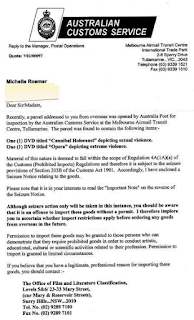Kill Craft (2024, dir. Mark Savage, USA)
Sixteen-year-old Marina Delon’s (Sanie Loutsis) life to date has been one of many contrasts. She lives on an idyllic, serene homestead surrounded by lush woodlands and a nearby beach. However, her father Thomas’ (Michael Pare) occupation is anything but sedate – he is a professional hitman (although Marina is unaware of the true nature of Thomas’ work). Marina has a close relationship with her dad, but not with her mother Ruth (Amy DiLorenzo), who is paralysed from the waist down. Ruth is in a permanent stage of embitterment and rage at both her husband and daughter. Neither parent has disclosed the circumstances of Ruth’s incapacitation to Marina – all she knows is that it happened shortly after she was born. At school, Marina is a straight-A student, albeit a misfit. Her best friend, Freya (Isis Eggleston), is the antithesis of Marina’s studiousness; a punkish petty thief constantly scrapping with classmates and teachers. Freya has her own problems at home as her father is in jail; perhaps their unconventional home lives and “outcast” statuses at school formed the basis of this unlikely friendship. Whatever the reason, the girls share a close bond and Marina confides to Freya how much of her family life is shrouded in mystery. The pair try and figure out what exactly Thomas’ job is by following him when he periodically slips off to the beach to retrieve coded messages in hidden bottles. The messages contain information on Thomas’ assignments, and Freya assumes he is a spy. Marina correctly has a hunch that her father may be a contract killer. Thomas promises to be at Marina’s upcoming recital, which the young girl is overjoyed about, due to it being the first of her school events he has ever attended. Tragically, Thomas never makes it to the recital, as he is fatally shot in the course of his latest mission by vengeful enemies. Despite an agonising drive home in determination to upheld his promise to his daughter, he succumbs to death not long after. Marina discovers his body slumped over the wheel the next morning, but cannot bear to tell her mother the truth, instead pretending that he has moved out. She does however demand Gina confirm that her father was indeed a hitman, which she does, as well as revealing that she was accidently shot during an unsuccessful prior assassination attempt – the cause of her disability, and subsequent lifelong resentment. With mounting bills and her mother unable to work, Marina realises that she has no other choice but to take over Thomas’ work. With the help of her loyal pal Freya, who decodes the secret beach messages for her, she surprisingly finds herself warming to the job. But is this schoolgirl by day/killing machine by night aware that’s she’s now in grave danger, with those responsible for her father’s demise hot on her trail?
The
prolific, and seemingly endlessly energetic, director/screenwriter Mark Savage has hit another one out of the
ballpark with his latest action-horror offering Kill Craft. On a par
with my personal favourite Savage films Purgatory Road (2017) and
Hell’s Coming for You (2023), Kill Craft is straight out,
unpretentious entertainment from its typically unsubtle throw you in the deep
end beginning, to its satisfying conclusion. One of Savage’s trademarks is
ensuring outstanding technical quality within the constraints of limited
budgets, and Kill Craft provides
another example of this dedication. Scenes of genuinely beautiful
cinematography appealingly capture the picturesque main woodlands and beach
locations; emerald green and aqua blue hues really “pop”, and some stylishly executed
coloured lighting brings to mind a 1970s Eurocult aesthetic. Such visually
pleasant moments cleverly contrast with Kill Craft’s frank graphic
violence – decapitated limbs and close-ups of squelchy bits are aplenty –
providing a memorably jarring effect. Michael Pare, who also starred in
Savage’s 2021 Painkiller, delivers a superior performance here as the
ill-fated hitman trying to balance the utmost secrecy of his work with
maintaining a close father-daughter relationship. Pare and Sanie
Loutsis are effectively able to create this bond to an effect, which renders
the pivotal moment of Thomas desperately fighting against excruciating pain to
try and get to Marina’s recital, genuinely moving. Loutsis and newcomer Isis
Eggleston are also a likeable duo as “opposites attract” ride or die best
friends. Their adventures are somewhat reminiscent of a blood-soaked Nancy Drew
tale. Savage’s film universe often comprises of comic-book type characters at
odds, who stand out wildly, from the pretty (and/or pretty dull) middle-class
suburb/towns they inhabit. Thus the girls’ antics fit in perfectly in Kill
Craft. Special mention is for the welcome return of character actor and
Savage regular Bill Oberst Jr., as a self-flagellating, mother-fixated, heavily
scarred, bad brown-suited, psychotic henchman. With, apparently, extremely
repellent body odour. He is so repulsive both inside and out, the stench of
this ugliness (and poor hygiene) emanates off the screen. Kill Craft’s
music score is a more subtle affair, taking more of a back seat than usual,
however the film’s positive aspects more than make up for this. All and all, Kill
Craft makes for an enjoyable hour and a half viewing, punctuated with the usual,
fun, Savage Sinema eccentricities.





























